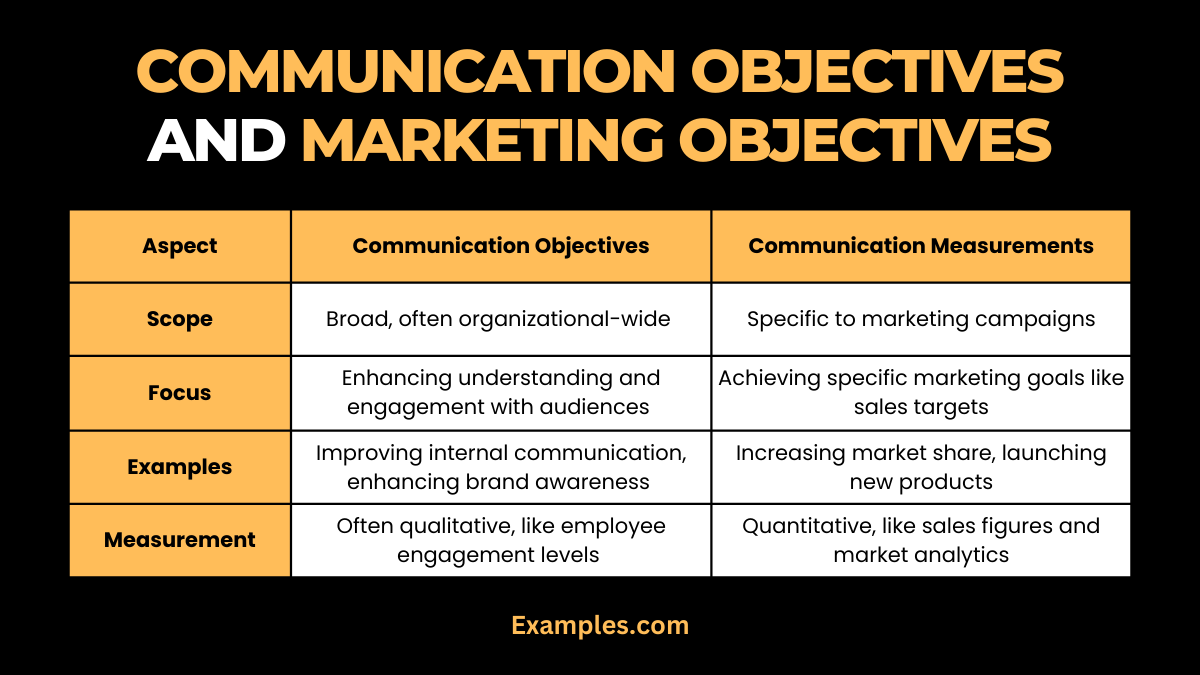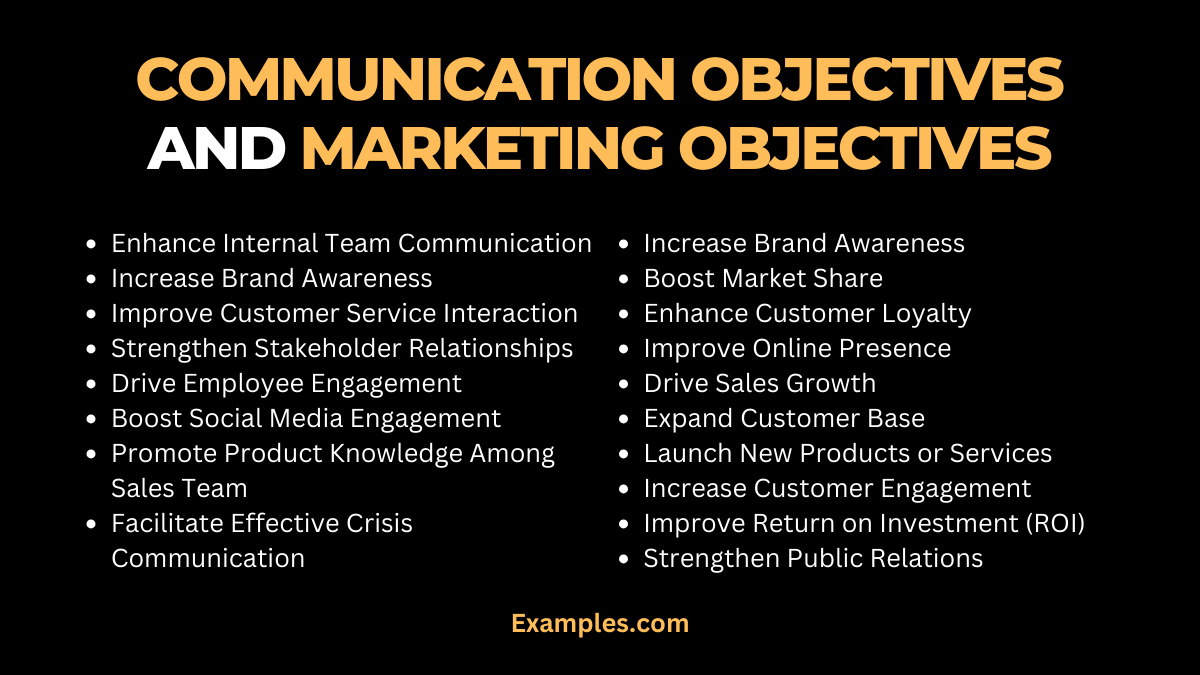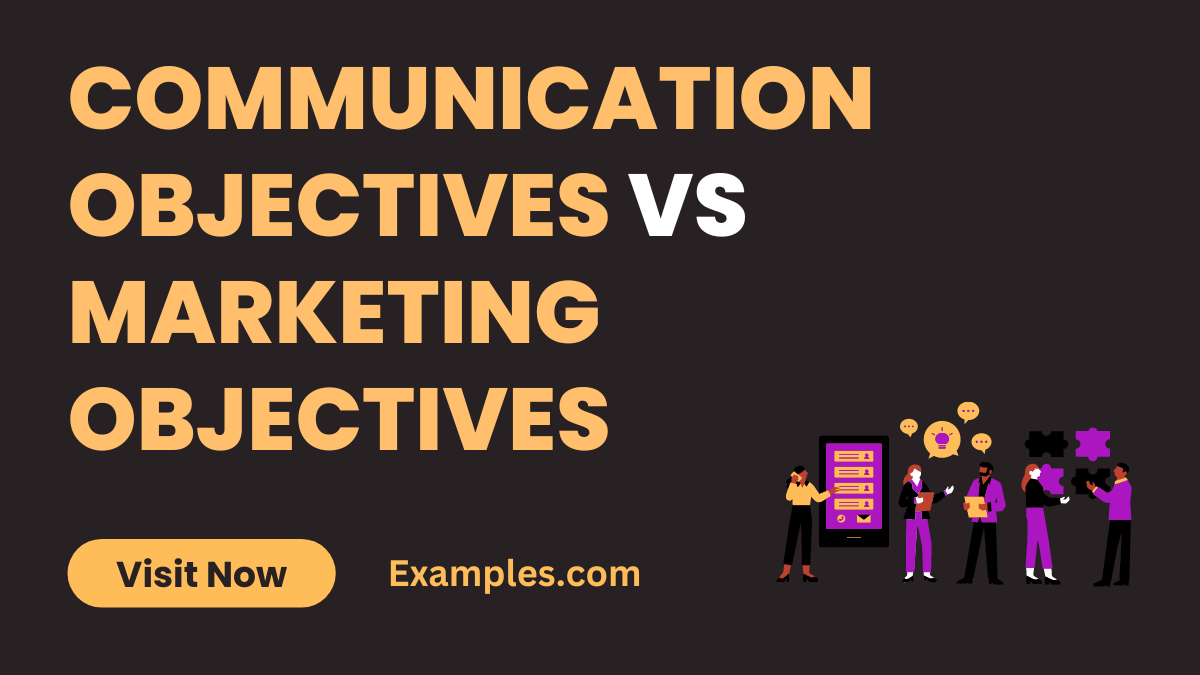Communication Objectives vs Marketing Objectives
Dive into the world of strategic planning with our guide on Communication Objectives vs Marketing Objectives, enriched with real-world communication examples. This detailed exploration provides insights into how these objectives differ and complement each other, crucial for any successful marketing strategy. Whether you’re a business professional, marketer, or student, this guide offers valuable knowledge on aligning communication strategies with marketing goals for optimal impact.
Download Communication Objectives PDF
Download Marketing Objectives PDF
Difference Between Communication Objectives and Marketing Objectives

| Aspect | Communication Objectives | Marketing Objectives |
|---|---|---|
| Focus | Enhancing understanding and engagement with audiences | Achieving specific marketing goals like sales targets |
| Scope | Broad, often organizational-wide | Specific to marketing campaigns |
| Examples | Improving internal communication, enhancing brand awareness | Increasing market share, launching new products |
| Measurement | Often qualitative, like employee engagement levels | Quantitative, like sales figures and market analytics |
In this table, we compare and contrast Communication Objectives with Marketing Objectives. While communication objectives focus on the overall messaging and audience engagement, marketing objectives are typically more targeted and quantifiable, aiming at specific business goals. It covers various Types of Communication Objectives, from Awareness Building and Information Dissemination to Persuasion and Brand Reinforcement. Understanding this distinction is vital for creating cohesive and effective business strategies.
10 Communication Objectives Examples

Explore our curated list of 10 Communication Objectives Examples, essential for any effective communication strategy. From enhancing team dynamics to boosting brand presence, such as those developing Communication Objectives for Therapy, Communication Objectives for Treatment Plans, or even Communication Objectives in Education, understanding the Importance of Communication Objectives is crucial.these objectives are vital in shaping successful interactions in various contexts. Each example comes with a brief explanation and illustrative sentences, providing a practical understanding of how to implement these objectives.
- Enhance Internal Team Communication: Aim to improve the clarity and frequency of communication within a team.
Example: Scheduling weekly team meetings to discuss progress and address any concerns. - Increase Brand Awareness: Focus on strategies to make your brand more recognizable.
Example: Utilizing social media campaigns to highlight brand values and offerings. - Improve Customer Service Interaction: Enhance the quality of interactions with customers.
Example: Training customer service representatives to effectively address and resolve customer issues. - Strengthen Stakeholder Relationships: Build and maintain strong relationships with key stakeholders.
Example: Regular updates and meetings with stakeholders to keep them informed and involved. - Drive Employee Engagement: Encourage active participation and involvement of employees.
Example: Implementing an internal platform for employees to share ideas and feedback. - Boost Social Media Engagement: Increase interaction with your audience on social media platforms.
Example: Creating engaging content and responding promptly to comments and messages. - Promote Product Knowledge Among Sales Team: Ensure the sales team is well-informed about products.
Example: Regular training sessions on product features and benefits. - Facilitate Effective Crisis Communication: Develop a plan to communicate effectively during crises.
Example: Preparing a crisis communication protocol with clear steps and spokespersons. - Enhance Public Speaking Skills: Improve the ability to communicate effectively in public speaking scenarios.
Example: Offering workshops and training sessions on public speaking and presentation skills. - Cultivate Media Relations: Develop and maintain positive relationships with media outlets.
Example: Regular press releases and media briefings to share company news and updates.
10 Marketing Objectives Examples
Discover a range of Marketing Objectives Examples, crucial for any successful marketing strategy. These objectives are tailored to enhance brand visibility, increase sales, and foster customer loyalty. We explore how these objectives, including Relationship Building communication objective, Audience Engagement communication objective, and Reputation Managemen communication objectivet, intersect with Marketing Objectives like Sales Enhancement, Market Positioning, and Stakeholder Trust Building. Each example demonstrates how specific goals can be strategically communicated and achieved through effective marketing initiatives.
- Increase Brand Awareness: Aim to make your brand more recognizable within a target market.
Example: Launching a social media campaign to introduce the brand to a younger demographic. - Boost Market Share: Focus on outperforming competitors in specific market segments.
Example: Introducing innovative product features to stand out in a crowded market. - Enhance Customer Loyalty: Strengthen the relationship with existing customers.
Example: Implementing a loyalty program that rewards repeat purchases. - Improve Online Presence: Increase visibility and engagement on digital platforms.
Example: Revamping the website for better user experience and SEO. - Drive Sales Growth: Achieve a specific increase in sales figures.
Example: Launching a time-limited promotion to boost short-term sales. - Expand Customer Base: Attract new customers to your products or services.
Example: Targeting new demographic groups with tailored marketing messages. - Launch New Products or Services: Successfully introduce new offerings to the market.
Example: Conducting a teaser campaign on social media before a product launch. - Increase Customer Engagement: Enhance the interaction with customers on various platforms.
Example: Creating interactive content to encourage customer participation. - Improve Return on Investment (ROI): Achieve higher returns from marketing expenditures.
Example: Focusing on high-performance marketing channels to optimize budget. - Strengthen Public Relations: Build and maintain a positive public image.
Example: Collaborating with influencers to amplify positive brand messages.
Comparison & Relationship Between Communication Objectives vs Marketing Objectives
Communication objectives and marketing objectives, while distinct, are interconnected. Communication objectives focus on effectively delivering messages and building relationships, essential for audience understanding and engagement. The guide addresses key aspects such as How to Write a Communication Objective?, the importance of Communication Training Objectives, and the role of Digital Marketing Communication Objective and Social Media Marketing Communication Objective in contemporary strategies. Both sets of objectives complement each other; effective communication strategies can significantly enhance the success of marketing campaigns, and vice versa, creating a cohesive approach to achieving overall business goals.
- Different Focus Areas: Communication objectives often focus on message clarity and audience engagement, while marketing objectives are more sales and market-oriented.
- Measurement Techniques: Communication objectives may use qualitative measures like audience feedback, whereas marketing objectives rely on quantitative data like sales figures.
- Scope of Application: Communication objectives can be broader and organization-wide, whereas marketing objectives are typically specific to marketing campaigns.
- Interdependency: Effective communication objectives can support and enhance marketing objectives, creating a cohesive strategy.
- Target Audience: Communication objectives may target internal and external stakeholders, while marketing objectives primarily focus on potential and existing customers.
- Strategic Alignment: Both sets of objectives need to align with the overall business strategy for maximum effectiveness.
- Timeframe for Achievement: Marketing objectives often have shorter, more defined timelines, while communication objectives can be long-term.
- Tools and Channels Used: Differing tools and channels are used to achieve these objectives, with marketing often leveraging advertising and promotional tactics, and communication focusing on PR and media relations.
- Role in Brand Building: Communication objectives lay the groundwork for strong relationships, while marketing objectives drive brand growth and market penetration.
- Impact Measurement: The success of marketing objectives is often easier to measure directly compared to the more subtle impact of communication objectives.
The Importance of Communication and Marketing Objectives
The importance of communication and marketing objectives lies in their ability to guide and shape the strategic importance of marketing to business. Communication objectives ensure that a clear, consistent message reaches the intended audience, fostering brand awareness and stakeholder trust. It highlights the need for alignment in Communication Objectives in Business, Communication Objectives in an Organization, and Project Communication Objective for achieving strategic goals and ensuring that efforts are not only well-coordinated and efficient but also aligned with the overall vision and goals of the organization.
- Guides Strategic Planning: Both sets of objectives provide a roadmap for crafting effective strategies.
- Enhances Brand Image: Effective communication and marketing objectives work together to build a strong brand image.
- Drives Business Growth: They are essential in driving sales, customer engagement, and business expansion.
- Improves Stakeholder Relationships: Clear objectives help in maintaining positive relationships with various stakeholders.
- Fosters Team Alignment: Ensures all departments work towards common goals.
- Optimizes Resource Allocation: Helps in efficiently allocating resources for maximum impact.
- Informs Decision Making: Provides a basis for making informed business decisions.
- Increases Market Competitiveness: Sharp objectives give an edge over competitors.
- Facilitates Customer Understanding: Helps in understanding and meeting customer needs.
- Boosts Overall Efficiency: Streamlines efforts across communication and marketing departments.
This guide presents a thorough understanding of Communication Objectives vs Marketing Objectives, underscoring their distinct roles and interplay in achieving business success. This guide is an invaluable resource for professionals seeking to understand and implement Smart Communication Objectives, Communication Campaign Objectives, and Management Communication Objectives in a cohesive manner.It emphasizes how aligning these objectives is crucial for strategic planning, brand enhancement, and overall organizational growth, providing essential insights for professionals in any field.



